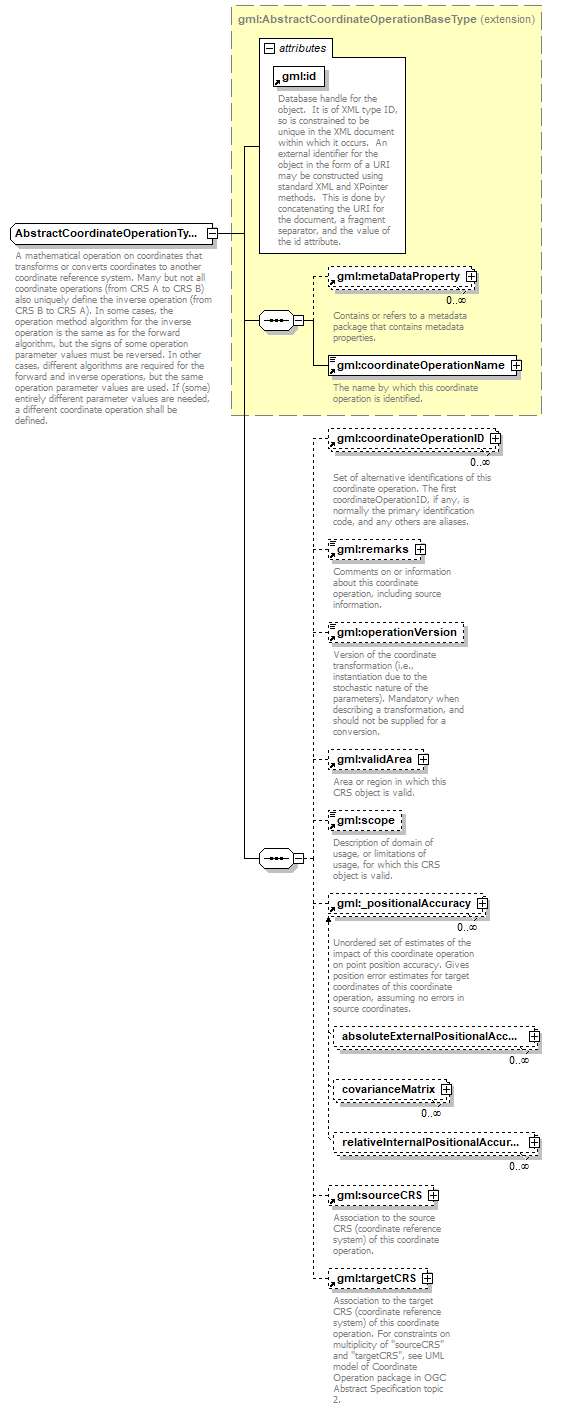| diagram |  |
||||||||||||||
| namespace | http://www.opengis.net/gml | ||||||||||||||
| type | extension of gml:AbstractCoordinateOperationBaseType | ||||||||||||||
| properties |
|
||||||||||||||
| children | gml:metaDataProperty gml:coordinateOperationName gml:coordinateOperationID gml:remarks gml:operationVersion gml:validArea gml:scope gml:_positionalAccuracy gml:sourceCRS gml:targetCRS | ||||||||||||||
| used by |
|
||||||||||||||
| attributes |
|
||||||||||||||
| annotation |
|
||||||||||||||
| source | <xs:complexType name="AbstractCoordinateOperationType" abstract="true"> <xs:annotation> <xs:documentation>A mathematical operation on coordinates that transforms or converts coordinates to another coordinate reference system. Many but not all coordinate operations (from CRS A to CRS B) also uniquely define the inverse operation (from CRS B to CRS A). In some cases, the operation method algorithm for the inverse operation is the same as for the forward algorithm, but the signs of some operation parameter values must be reversed. In other cases, different algorithms are required for the forward and inverse operations, but the same operation parameter values are used. If (some) entirely different parameter values are needed, a different coordinate operation shall be defined.</xs:documentation> </xs:annotation> <xs:complexContent> <xs:extension base="gml:AbstractCoordinateOperationBaseType"> <xs:sequence> <xs:element ref="gml:coordinateOperationID" minOccurs="0" maxOccurs="unbounded"> <xs:annotation> <xs:documentation>Set of alternative identifications of this coordinate operation. The first coordinateOperationID, if any, is normally the primary identification code, and any others are aliases. </xs:documentation> </xs:annotation> </xs:element> <xs:element ref="gml:remarks" minOccurs="0"> <xs:annotation> <xs:documentation>Comments on or information about this coordinate operation, including source information. </xs:documentation> </xs:annotation> </xs:element> <xs:element ref="gml:operationVersion" minOccurs="0"/> <xs:element ref="gml:validArea" minOccurs="0"/> <xs:element ref="gml:scope" minOccurs="0"/> <xs:element ref="gml:_positionalAccuracy" minOccurs="0" maxOccurs="unbounded"> <xs:annotation> <xs:documentation>Unordered set of estimates of the impact of this coordinate operation on point position accuracy. Gives position error estimates for target coordinates of this coordinate operation, assuming no errors in source coordinates. </xs:documentation> </xs:annotation> </xs:element> <xs:element ref="gml:sourceCRS" minOccurs="0"/> <xs:element ref="gml:targetCRS" minOccurs="0"/> </xs:sequence> </xs:extension> </xs:complexContent> </xs:complexType> |
XML Schema documentation generated by XMLSpy Schema Editor http://www.altova.com/xmlspy